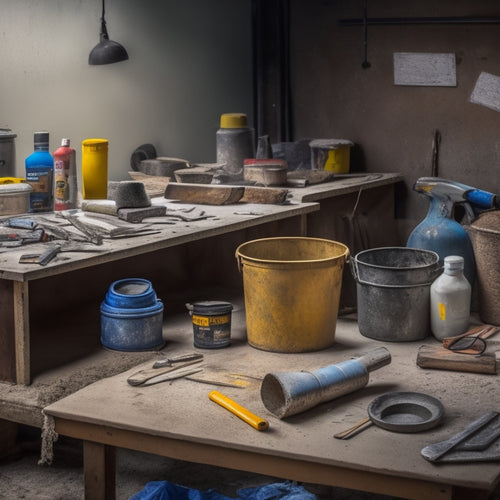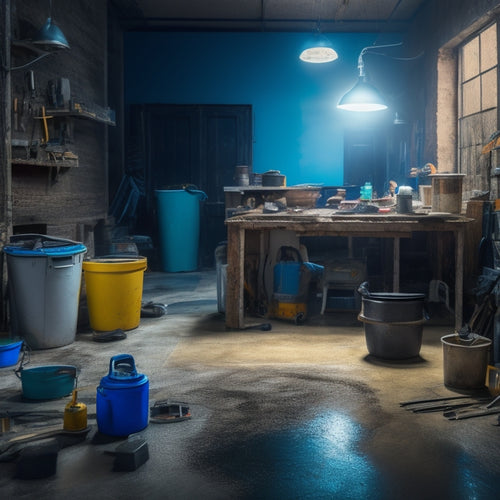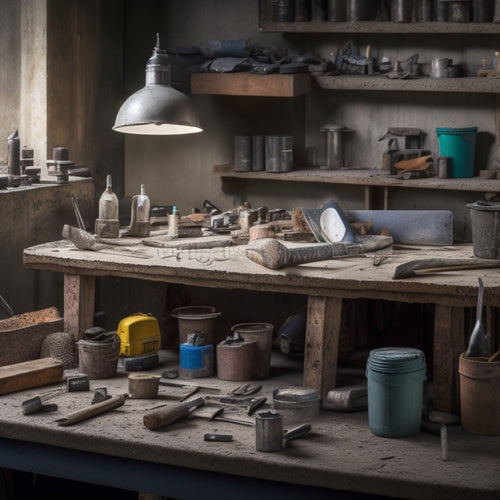
What Tools Do Beginners in Concrete Need
Share
You'll need a solid set of essential tools to get started with concrete finishing, including a mixing bucket, trowel, bull float, and edger, which will enable you to prepare, pour, and finish concrete surfaces with confidence. A toolbox with dividers and stackable storage containers will keep your tools organized and within reach. As you gain experience, you can expand your toolkit to include specialized tools for textures, power tools for smoother finishes, and techniques for achieving a high-gloss finish. With the right tools and knowledge, you'll be well on your way to producing professional-looking concrete projects that showcase your skills.
Key Takeaways
- Beginners in concrete need a mixing bucket, trowel, bull float/darby, edger/jointer, and tamping tool/hand tamper for essential concrete finishing tasks.
- A toolbox with dividers, stackable storage containers, and pegboards with hooks can help keep tools organized and within reach.
- Mastering trowel techniques, including floated finish, steel trowel use, and finished trowel application, is crucial for a professional finish.
- Power tools like vibratory screeds, walk-behind power trowels, and concrete grinders can help achieve smoother finishes and increased productivity.
- Specialized tools like texture stamps, surface rollers, and bump cutters can be used to create unique textures and patterns on concrete surfaces.
Essential Tools for Concrete Finishing
Most concrete finishing projects require a handful of essential tools to achieve a smooth, even surface.
You'll need a mixing bucket, a mixing stick or trowel, and a scraper for surface preparation. A bull float or darby helps to level and smooth the concrete, while an edger or jointer is necessary for creating clean edges and joints. You'll also need a tamping tool or hand tamper to compact the concrete and remove air pockets.
When it comes to mixing techniques, a mixing bucket with a sturdy handle and a mixing stick or trowel with a curved or angled blade will make the process more efficient.
For surface preparation, a scraper with a flat or angled blade is ideal for removing debris and old adhesive. A level and a measuring tape will also come in handy to guarantee your surface is even and level.
Remember to choose tools that fit comfortably in your hand and are made of durable materials to withstand the demands of concrete finishing.
With these essential tools, you'll be well on your way to achieving a professional-looking finish.
Concrete Tool Storage Solutions
Now that you've assembled your arsenal of concrete finishing tools, it's time to think about how you'll keep them organized and within reach.
Effective tool organization is essential for efficiency and productivity on the job site. Without a proper storage system, you'll waste time searching for misplaced tools, and your work will suffer as a result.
To maintain a well-organized workspace, consider the following storage solutions:
-
Toolboxes with dividers: Separate your tools into categories to prevent clutter and make them easy to find.
-
Stackable storage containers: Keep your tools and materials off the ground and out of the way, while maximizing your storage capacity.
-
Pegboards with hooks: Hang your most frequently used tools within easy reach, keeping them organized and saving space.
-
Mobile storage carts: Transport your tools and materials around the job site with ease, keeping them organized and accessible.
-
Clear storage bins: Label and store small items like fasteners, adhesives, and other consumables, keeping them visible and easily accessible.
Finishing Concrete by Hand Tools
With a solid storage system in place, you're ready to focus on the art of finishing concrete by hand. This stage requires precision and patience, as you'll be working with freshly poured concrete to achieve the desired texture and finish.
To achieve a smooth, even finish, you'll need to become proficient in various trowel techniques. These include applying a floated finish, using a steel trowel to remove excess water and create a smooth surface, and applying a finished trowel to create a high-gloss finish.
| Hand Tool | Description |
|---|---|
| Steel Trowel | Used to remove excess water and create a smooth surface |
| Finished Trowel | Used to create a high-gloss finish |
| Edger | Used to create a clean, defined edge |
When it comes to curing methods, you'll need to guarantee the concrete is protected from the elements and allowed to cure slowly. This can be achieved by applying a curing compound or using a concrete sealer. By mastering these hand tools and techniques, you'll be able to achieve a professional-looking finish that will last for years to come.
Power Tools for Smoother Finishes
Take your concrete finishing skills to the next level by incorporating power tools into your arsenal.
You've mastered the basics with hand tools, now it's time to achieve smoother, more efficient results with the help of power tools.
When it comes to power tools, you'll want to take into account the following essentials for a professional finish:
-
Vibratory screeds: These machines help to flatten and smooth out freshly poured concrete, achieving a uniform surface and reducing the risk of imperfections.
-
Walk-behind power trowels: Perfect for larger areas, these tools allow you to cover more ground quickly and efficiently, while still maintaining control over the finishing process.
-
Ride-on power trowels: For even larger projects, ride-on power trowels provide the ultimate in efficiency and productivity, allowing you to cover huge areas in a fraction of the time.
-
Concrete grinders: These tools are perfect for removing imperfections and old coatings, preparing the surface for a new finish.
-
Edgers and joint cutters: For a professional finish, you'll need to guarantee crisp, clean edges and joints, which is where these specialized tools come in.
Specialized Tools for Textures
You've perfected the art of achieving smooth finishes with power tools, but concrete textures require a different set of specialized tools to bring out unique visual effects. To create intricate patterns, designs, and textures, you'll need tools that can manipulate the concrete without compromising its structural integrity.
| Tool | Purpose |
|---|---|
| Texture Stamps | Create patterns, designs, and textures on concrete surfaces |
| Surface Rollers | Achieve uniform textures, remove air pockets, and create subtle patterns |
| Tamping Tools | Compact and flatten freshly poured concrete for a smooth finish |
| Bump Cutters | Create small, rounded bumps on concrete surfaces for a unique effect |
These specialized tools allow you to achieve various textures, from subtle to dramatic, and add an extra layer of visual interest to your concrete projects. When working with texture stamps, make sure to press them firmly and evenly to achieve a consistent pattern. Surface rollers, on the other hand, require gentle pressure to avoid creating air pockets or uneven textures. By mastering these tools, you'll be able to create stunning concrete textures that enhance your projects to the next level.
Frequently Asked Questions
What Safety Gear Is Necessary When Working With Concrete?
When working with concrete, you need personal protective gear to shield yourself from concrete hazards, including gloves, safety glasses, dust mask, and steel-toed boots to prevent skin contact, eye damage, respiratory issues, and foot injuries.
Can I Use Regular Gardening Gloves for Concrete Work?
You shouldn't use regular gardening gloves for concrete work; they lack the glove durability to protect your hands from concrete hazards like abrasion, chemical exposure, and heavy impacts, putting you at risk of serious injury.
How Do I Clean and Maintain My Concrete Tools?
Like a chef prepping for a new dish, you must season your concrete tools with regular cleaning and maintenance; scrub off dried cement with a wire brush, then lubricate moving parts to keep them running smoothly and prolong their lifespan.
Can I Rent Concrete Tools Instead of Buying Them?
You can definitely rent concrete tools instead of buying them, exploring rental options that offer cost savings and flexibility, especially for infrequent or one-time projects, allowing you to access specialized equipment without a hefty upfront investment.
What Is the Ideal Temperature for Working With Concrete?
When you're working on a concrete project, like the one in Denver where they poured a 10,000 sq. ft. slab, you'll want to guarantee the ideal temperature for concrete curing is between 50°F and 75°F, as temperature effects can greatly impact the final product's strength and durability.
Conclusion
As you commence your concrete expedition, remember that your tools are the brushes that paint your masterpiece. With each stroke, they shape and mold the concrete into a work of art. The right tools in your arsenal will be the difference between a rough, unfinished canvas and a smooth, polished gem. Invest in yourself and your craft, and your concrete creations will be a demonstration of your skill and dedication.
Related Posts
-

3 Best Tools to Buy for Concrete Repair Online
When buying tools for concrete repair online, you'll want to research multiple retailer options to find the best prod...
-

Essential Tools for Epoxy Concrete Floor Repair
You'll need a thorough arsenal of specialized tools to guarantee a successful epoxy concrete floor repair. Floor prep...
-

Top Tools for Concrete Repair Success
When it comes to concrete repair success, you'll need a well-stocked toolkit with essential hand tools like trowels, ...


